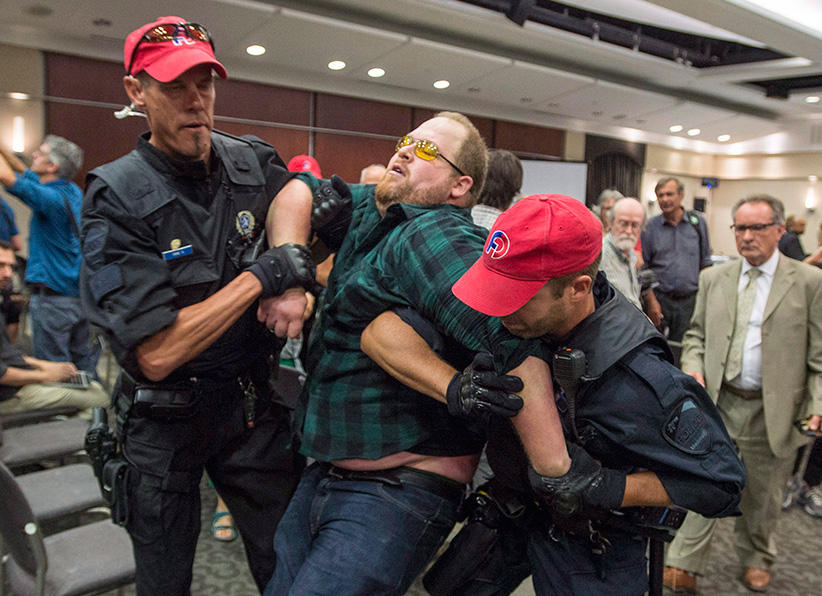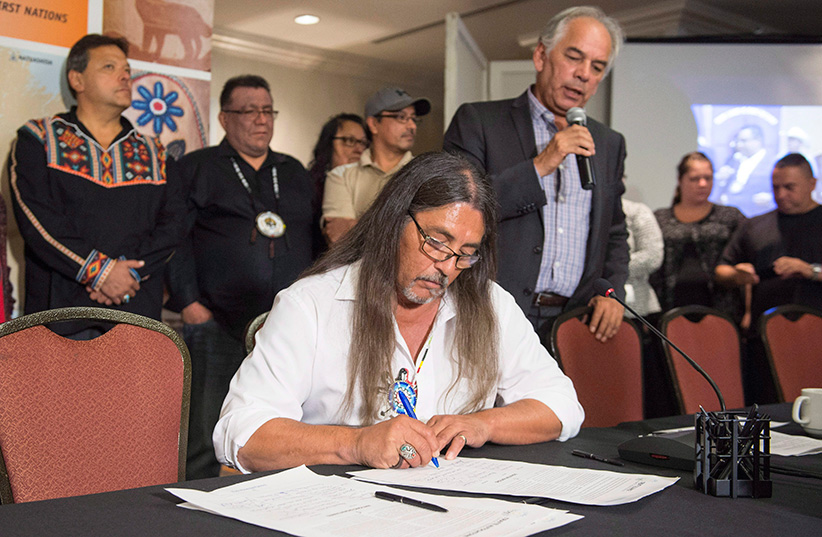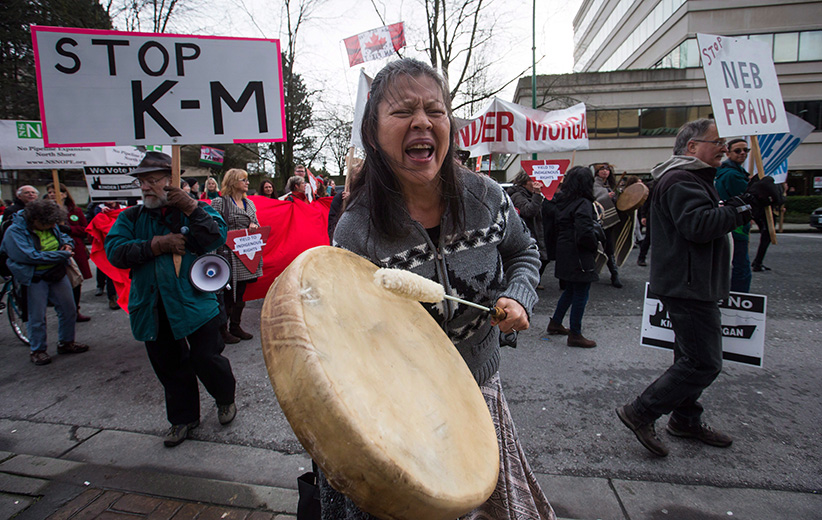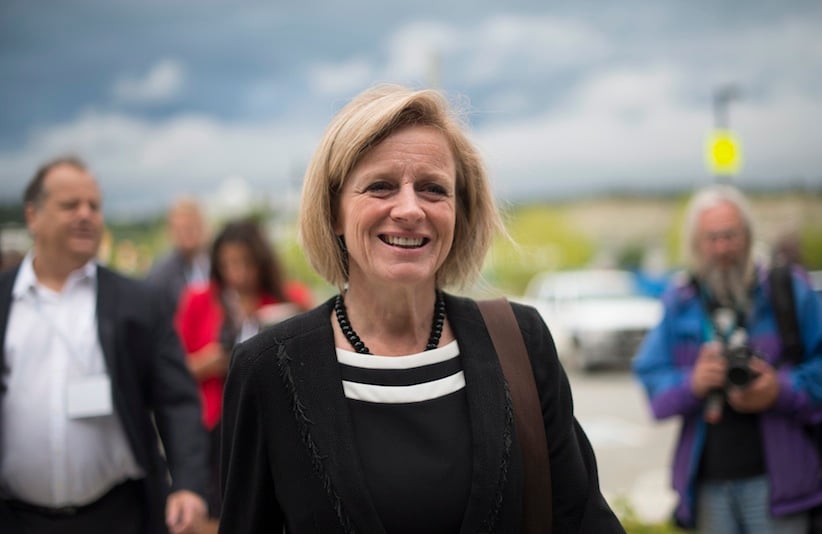Why Trudeau and the oil industry are losing the pipeline battle
New oil sands pipelines may be vital for the industry, but opponents are winning
Patricia Kelly, of the Sto:lo First Nation, chants and beats a drum during a protest outside National Energy Board hearings on the proposed Trans Mountain pipeline expansion in Burnaby, B.C., on Tuesday January 19, 2016. The proposed $5-billion expansion would nearly triple the capacity of the pipeline that carries crude oil from near Edmonton to the Vancouver area to be loaded on tankers and shipped overseas. (Darryl Dyck)
Share

The pipeline people first visited Serge Simon in the fall of 2014, bearing not gifts but questions. Simon, the grand chief of the Montreal-area reserve of Kanesatake, had heard about the TransCanada Energy East project, the 4,500-km, $15.7-billion pipeline that would deliver the fruits of Alberta’s oil sands to the East Coast. The country’s oil industry has said a new pipeline is crucial for the development of the oil sands, which is projected to produce over 5.5 million barrels a day by 2030, according to a 2016 Canadian Association of Petroleum Producers (CAPP) report.
A section of the pipeline would cross through a 675-sq.-km parcel of land claimed by Kanesatake. Several council chiefs “wanted to kick TransCanada out completely. They didn’t want to talk to them, they didn’t want to hear anything,” Simon says. “I wanted to show good faith.”
So he listened. “We started talks, everything was going well. Then all of a sudden they started asking questions: ‘We’re going to need to know your use of the land where the pipeline is passing. We need to know your traditional knowledge of plants and animals in that area that might be affected by this project. What are your activities on those lands today?’ ”
Simon worried that answering these questions would prejudice Kanesatake’s land claim with the federal government. “When they said that, I said, ‘OK, that’s it. All talks are off.’ ” He politely asked TransCanada to leave.
Then he began to read: about the process of extracting Alberta bitumen, about climate change, about alternative energy sources both practical and fantastical. He stopped worrying about the route of TransCanada’s proposed pipeline, and started questioning its very legitimacy.

He spearheaded talks with other Native bands across the country. Eighteen months later, some 87 bands have signed onto the Treaty Alliance Against Tar Sands Expansion, which aims to prevent the development of any pipeline carrying bitumen from Alberta—all told, four pipeline projects representing a daily capacity of more than three million barrels. “Those pipelines are not coming through. They’re wasting their money,” Simon declared at the press conference announcing the treaty.
Pipeline opposition has jumped the often fraught line between Indigenous and non-Indigenous politicians. Vancouver Mayor Gregor Robertson, a vocal opponent of Kinder Morgan’s Trans Mountain project in B.C., has been in talks with Montreal Mayor Denis Coderre, who opposes Energy East. “We’re on the same page with the Montreal and Quebec communities,” Robertson told Maclean’s, calling the federal pipeline approval process “disastrous.”
In 2013, Liberal leader Justin Trudeau assailed the Conservative government for having “failed to move the yardsticks” on pipelines—which he called “the most important infrastructure projects of our generation.” Getting oil to the coast would reduce the discount at which it is currently sold and remove supply bottlenecks. It would also reassure investors of the long-term viability of the oil and gas industry, Canada’s largest private sector investor.
Yet three years later those yardsticks have hardly budged, and may have inched backwards. National Energy Board hearings into Energy East have been postponed due to protest and board resignations. In B.C., a judge overturned the two-year-old approval for the Northern Gateway pipeline in B.C., pending proper Indigenous consultation. And while the cabinet may approve Trans Mountain by Christmas, it would be doing so as pushback grows. Indigenous bands and environmental groups have promised fresh opposition on both sides of the country. Practically and politically, building pipelines is incredibly hard. It may have become impossible.
In Canada, the politics of pipelines have helped topple governments. In 1956, Trans-Canada Pipe Lines Ltd, the American predecessor of the Calgary-based company behind Energy East, sought a loan of $80 million (about $700 million in today’s dollars) from the federal government to build a natural gas pipeline from Alberta to Montreal. By lending millions of dollars to a Texas-based company, the Liberals bruised an already fragile collective nationalism. The government of Louis St-Laurent lost the next election largely as a result, putting an end to a 22-year Liberal reign.
By adding bits to either end, TransCanada hopes this very pipeline will flow with bitumen from Hardisty, Alta., to Saint John, N.B., in 2021, the projected completion date. The issue this time around is less nationalist than environmental—particularly along the 650 km route through Quebec.
Recently, Quebec Premier Philippe Couillard voiced Quebecers’ “legitimate” concerns over the Energy East project. “It’s not a popular or political expression of negativity toward the West; it’s just normal concerns by citizens over their freshwater reserves,” he told Bloomberg News.

Other Quebec politicians have been less diplomatic. Last January, the mayors of 82 Montreal-area towns, including Montreal Mayor Coderre, formally opposed the Energy East project. According to a December 2015 report from the Communauté métropolitaine de Montréal (CMM), the body representing these 82 mayors, the Energy East pipeline would present an “imbalance between the considerable environmental and security risks and weak economic impacts for the Greater Montreal region.” (The project will generate about 33 permanent jobs in Quebec once built, according to NEB filings.)
Coderre adds arrogance to this list of affronts. “There was a lack of respect” from TransCanada, Coderre says. Nearly 4,000 citizens participated in the CMM hearings on the project. Some 143 memoranda were submitted. Despite this, the company refused to participate.
“It’s a bad project,” Coderre says today. “It’s not okay to ask to build a new pipeline and not have the dignity to respect the plan that we put forward to protect our wetlands and all that,” Coderre says. “It’s a fact of life. You have to work with us, even if you don’t like it. If I don’t have any answers, I’m sorry, but I’m not going to give you a blank cheque.”
One of the issues is language. TransCanada’s English-language documents appear on the NEB site; TransCanada’s filings in French appear on TransCanada’s own website. In one document, regarding the pipeline crossing the St Lawrence River, the English version recommends a “stage III assessment,” a “detailed investigation and/or mitigation of an identified hazard.” In the report, published by Calgary-based environmental consultant Golder Associates in March 2015, the St. Lawrence is the only waterway listed as warranting a Phase III assessment—perhaps because of the river’s size and discharge level, the country’s largest. Yet the French version of the same report omits the Phase III recommendation.
As with the St. Lawrence, the proposed pipeline will pass underneath the Ottawa River in Quebec’s Outaouais region. Yet according to a feasibility report prepared by Calgary-based Entec Engineering Technology for TransCanada in June 2014, boring under the Ottawa River “is technically unfeasible” and would likely lead to “extra costs, delays and increased environmental impacts.” (The report, which has since been removed from TransCanada’s filings, is still on Quebec’s environment ministry website.)
TransCanada readily admits it has failed in Quebec on the public relations front. In September 2015, after roughly a year of mostly negative press coverage in the province, the company hired Louis Bergeron as its vice-president for Quebec and New Brunswick. An industry veteran, Bergeron’s specialty is selling pipeline projects to a skeptical public. Notably, he oversaw the construction of the Pipeline St-Laurent project, a 250-km pipeline through which flows petroleum products from Ultramar’s facilities in Lévis, Que., to Montreal.
He says there are nuances to Quebec’s political and social landscape that TransCanada didn’t comprehend at the outset of the project. “Quebecers look at pipelines and big projects in general with a different eye than the rest of Canada,” Bergeron says. “Whatever the project, we know it will be obsessed over, we know that certain groups will be vocal, and certain politicians as well. It’s part of the Quebec landscape, and you just have to accept it.”
Quebec isn’t TransCanada’s only hurdle. The NEB hearings regarding Energy East have been postponed, following the resignation of two NEB board members amidst revelations from the National Observer website that they, along with NEB board chairman Peter Watson, met with former Quebec premier Jean Charest in 2015. Charest was consulting for TransCanada at the time. (Watson has also recused himself from the Energy East hearings.)
The ensuing delay in the hearings, which have been pushed back indefinitely, means a decision on the project may become a political issue for Trudeau in the 2019 federal election. Should public and political opinion in Quebec not be swayed by then, Trudeau faces the prospect of okaying an unpopular pipeline through a province where he counts some 40 MPs, many of whom were elected based on his environmental stance. The Montreal-area Indigenous reserves of Kanesatake and Kahnawake are within driving distance of Trudeau’s own riding—and both oppose Energy East.
It doesn’t look good. “The chances that Energy East will cross the province of Quebec are very low,” says Pierre-Olivier Pineau, an energy policy professor at Montreal’s Haute Études Commercial. “There’s more to gain for the politicians, who want to be on the side of virtue.”

With Energy East hearings set for a reboot, Northern Gateway pushed back by courts and Keystone XL cut off at the U.S. border, the oil industry’s next pipe dream snakes from Edmonton through Jasper National Park, roughly along B.C.’s Coquihalla Highway down into the Fraser Valley, ending at a shipping terminal in Burnaby. By Dec. 19, the federal cabinet will decide whether to approve the Trans Mountain expansion, which traces most of the route of Kinder Morgan’s existing Trans Mountain oil conduit.
It’s long been Trudeau’s favourite son among proposed pipelines: “I certainly hope that we’re going to be able to get that pipeline approved,” he told Metro Calgary in 2014. When his party bid for Lower Mainland seats last fall, it attacked not the pipeline but the regulatory process, promising overhauled NEB and environmental assessment processes.
Trudeau also said things many sides wanted badly to hear: that he was committed to tackling climate change and ensuring more respectful dealings with First Nations, and that he wanted market access for Canada’s resources.
After boosting the party’s B.C. seat count to 17 from two, mostly in the Vancouver area, the Liberals announced the already scheduled NEB hearings would go ahead. The interim “overhaul” would be a three-member panel, which Natural Resources Minister Jim Carr named to hold additional non-regulatory hearings aimed at capturing anything beyond the technical narrowness of an energy board review.
Pipeline critics howled that Harper’s method of NEB hearings, with no oral cross-examinations and other constraints, would remain the new regime’s method—though if the panel was to get a word in edgewise, speak they would. As this ministerial panel wended westward from Alberta this summer—after the NEB’s formal recommendation to approve Trans Mountain, with 157 conditions on environmental mitigation, consultation and more—hearings became increasingly one-sided, raging about spill risk, oil sands emissions and the process itself.
About 91 per cent of the 651 presenters were anti-pipeline, estimates Stand, one of the key B.C. environmental groups corralling such protest. Kinder Morgan Canada president Ian Anderson credits those few dozen who “bravely” spoke in favour, mainly businesses and building trades groups. “I think it did create an opportunity for grandstanding and loud voices at the mic, but that’s not uncommon,” Anderson tells Maclean’s. But this extra hearing layer gave him confidence Kinder is already on top of the challenges it faces: “We didn’t really hear anything new.”
Pro-pipeline groups like the Business Council of B.C. also were participants in a set of hearings they didn’t love. But if it eased Trudeau to a “yes,” they wouldn’t protest.
This panel hands in a narrative report this November, but won’t make a recommendation. Karen Mahon, Stand’s Canadian director, says it’s dangerous for the Liberals to have so blithely offered up a platform for grievances. “Asking someone what they think, and then not taking into account what they said to you, is actually a way to manufacture dissent,” she says.
Stand was, until recently, called ForestEthics, a U.S.-based group with roots in logging protest. Mahon was part of the Clayoquot Sound standoff in the 1990s, which led to mass prosecutions of those in the logging trucks’ way, as well as then-NDP government’s provincial protections against clear-cutting old-growth forest. This could similarly harden the core opposition, she says. “Will Kinder Morgan become Trudeau’s Clayoquot? It’s a very similar feeling, a good government trying to please everybody. But in some places that’s just not possible.”
Clayoquot was a battle on the rugged west edge of Vancouver Island; Trans Mountain terminates in Canada’s third-largest metropolitan centre, increasing monthly oil tanker traffic from five to 34. “You expect with this volume of product, there will be spills,” Robertson says.
Kinder Morgan has had 84 reported pipeline spills along Trans Mountain since 1961, mostly small but also a 2007 rupture accident that forced 250 Burnaby resident evacuations and spilled 250,000 litres into the tidewater. Trans Mountain’s tanker operations have never caused such problems, and the NEB found a “very low probability” of a major spill, but the City of Vancouver argues a potential catastrophe threatens tourism and its green brand.
In November 2014, dozens of protesters were arrested for blocking Kinder’s geotechnical survey work on Burnaby Mountain. Among them was Mahon and Stewart Phillip, grand chief of the Union of B.C. Indian Chiefs. “I’m always at the front lines. I could very well be arrested again. And I’m fully prepared to,” he says.
Phillip encouraged his political organization’s member bands to join the anti-pipeline treaty. Fronting in Vancouver was Rueben George of Tsleil-Waututh, whose lands sit across Burrard Inlet from the tanker terminal, and deems the expansion an “unacceptable risk to the water, land and people.”
Tsleil-Waututh lost one court challenge against the pipeline plan this summer, and promptly launched a second one. The Federal Court of Appeal docket is thick with judicial reviews from other Indigenous bands, and environmental groups, and the cities of Vancouver and Burnaby. They all stood firmly opposed before Trudeau took 24 Sussex. They haven’t budged since, for all the Prime Minister’s talk of nation-to-nation relationships and consensus building.
One line he used while campaigning, and as recently as March, has come back at him like an episode of “When Catchphrases Attack.” “He said that yeah, government can grant permits, but it’s communities that grant permission,” Burnaby Mayor Derek Corrigan told the ministerial panel. “Well, we don’t.”
A reporter asked Trudeau about that permission axiom last week. He didn’t go near it. “Canadians expect us to make the difficult decisions on how to grow the economy and protect the environment at the same time,” he said, one week after Bloomberg News reported the PM plans to approve at least one new pipeline in his first term, citing anonymous sources. Rather than his predecessor’s role as a “cheerleader,” Trudeau fancies his government a referee, reaching for middle ground.
But come decision time, cabinet will have to determine the national interest. That must include Vancouver and First Nations groups, and also Alberta. There, a pipeline is widely seen as an escape route from economic anguish. The province’s unemployment rate is the highest outside Atlantic Canada; a cabinet OK on Kinder Morgan won’t raise the price of oil, but advocates hope it sparks investor confidence that costly oil sands expansions won’t be bottlenecked, with only costly and less safe rail as the alternative. “If we can’t develop at least some additional pipelines to get our oil and gas to market, Canadians will lose jobs, face a lower dollar and have to find other sectors to tax if we want to cover the costs of health and education, and so much more,” Royal Bank CEO Dave McKay said in Edmonton this week.

Alberta NDP Premier Rachel Notley has taken a different approach from her conservative forebears as well. She avoids public spats with environmental hardliners and brusqueness from the likes of Coderre; she leaves those volleys to the Wildrose opposition and Saskatchewan Premier Brad Wall, and sometimes Calgary Mayor Naheed Nenshi.
Notley’s approach has been the carrot: a climate change plan highlighted by an economy-wide carbon tax and megatonnage cap on oil sands emissions. She bid to capture environmentalists’ respect—Mahon stood on stage at the plan’s launch—and remove two arrows from the anti-pipeline quiver: that oil sands pollution would grow unfettered as the province dragged its knuckles on climate action.
It didn’t convert Mahon’s group; she applauds the Notley plan, but says there’s so much else to loathe about the pipeline, like spill threat and impact on marine life.
Meanwhile, this new Indigenous alliance uses the more derogatory term “tar sands,” and the no-more-pipelines Leap Manifesto has since found partial support within the federal NDP. “These things don’t happen overnight. The way they change is through subtle shifts in tone and that’s what I think we’re seeing,” Notley tells Maclean’s. “Will all people be completely cool? No. Are we getting closer to a point where a critical mass of people are sufficiently cool? I think maybe.”
With the December cabinet decision on Trans Mountain fast approaching, Trudeau does not have the luxury of waiting for subtle shifts. His government has already angered B.C. Indigenous and eco groups this week by endorsing a $11.4-billion liquefied natural gas project on the North Coast, after saying yes to the controversial Site C hydro dam in August.
Meanwhile, the bullhorns continue to blare from the debates’ edges. Quebec and B.C. Indigenous leaders have linked arms to amp up political pressure, while the oil lobby has been trying to put its proud, pan-Canadian hand up for a while. The sector’s main advocacy group, CAPP, has long been broadcasting ads urging “energy citizens” to hold balanced discussions, with images of smiling people’s hands encircled by white maple leaves.
The voice for more junior and mid-size players, the Canadian Association of Oilwell Drillers and Contractors (CAODC), has gone punchier: its Oil Respect campaign demands Canadians stand up for hard-working families in what its website—in English only—calls the “most regulated and technologically advanced industries in the world.”
One campaign graphic criticizes Quebec for importing 90 per cent of its oil, much of it from “corrupt regimes” like Algeria. But if Oil Respect is trying to persuade Québécois, it’s doing so without a French website. “Oil Respect is a grassroots campaign. It’s on a shoestring budget from our association,” says CAODC president Mark Scholz.
NEB filings for Trans Mountain show that among the 97 B.C. Indigenous communities Kinder consulted along and around the route of pipe and tankers, at least two dozen wrote letters of support or have agreements with the pipeline company, although Kinder could not fully confirm Maclean’s list. Twenty-six of those bands were early signatories to the new anti-pipeline treaty. Three bands managed to show up on both lists: supporting Trans Mountain and opposing it and its tubular cousins. Two of them said they were added to the anti-oil treaty as a misunderstanding.
“I didn’t know we were opposed,” said Seabird Island Band Chief Clem Seymour, when first asked about the pact. “Kinder Morgan, we’ve always worked with them. We were talking to them about fixing the past relationship.”
Fundamentally, the process by which pipelines are approved hasn’t changed at all since the election of the Liberal government. What has changed are expectations. Whereas Kanesatake Chief Simon pronounces Stephen Harper’s name as though it were a bad taste in his mouth, he says he respects Trudeau. “I think he’s trying to find a balance between the special interests in the oil industry and the needs of Indigenous people,” Simon says. Ultimately, though, “Trudeau has to respect my right to say ‘no.’ ”
It is a word Trudeau, and the rest of Canada, may have to get used to.